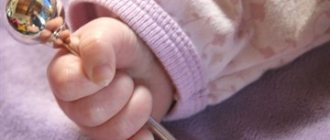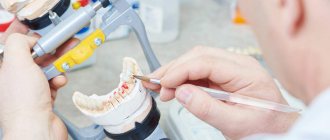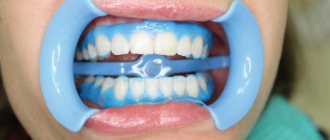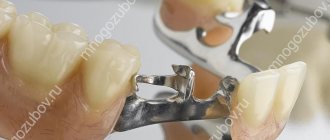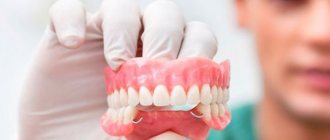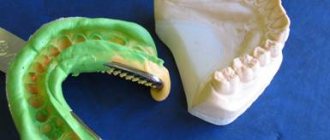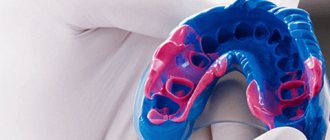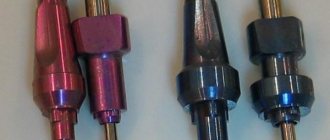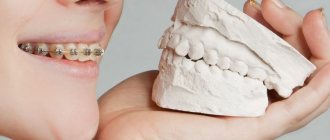Standard spoons
There is a wide range of standard impression trays on the market today. The first factor to take into account when choosing is the working jaw. For example, spoons for a moving jaw are equipped with a projection for the tongue and are shaped like a horseshoe, while products for a fixed jaw are similar to a regular spoon.
When it comes to choosing a partial impression, it is important to take into account the working side of the jaw.
Segmental designs
We are talking about spoons designed for simultaneous removal of models of both jaws. Instead of a bed of correctional mass, they are equipped with a thin layer of nylon or gauze. Like standard modifications, these spoons have sides.
The model removing compound is applied on both sides of the intermediate layer. Simultaneous taking of impressions from the lower and upper jaws allows you to reduce the duration of the procedure due to the absence of the need to additionally register the bite.
However, the practicality of using such a technique is controversial. In some cases it is quite difficult to obtain a universal impression. It is worth keeping in mind that insufficient rigidity of the spoon can negatively affect the quality of the finished model.
Another important aspect is the condition of the dentition. Spoons are made for patients with partial or complete edentia.
Material of manufacture
Spoons can be made of polystyrene, aluminum, steel and other materials, depending on the intended purpose. For example, metal products are used to obtain the most rigid impressions, and plastic structures are widely used in the field of implantology. In a number of clinical cases, plastic and metal products are interchangeable.
Where in Moscow is prosthetics performed using an individual spoon?
The production of an individual design is an important stage in preparation for prosthetics, the initial link in the sequence of actions, the result of which determines not only the ease of use of a removable denture, but also the quality of life.
The Levoberezhnaya Dental Clinic provides a full range of services in the field of orthopedic treatment, including the manufacture of an individual tray. You can make an appointment with our specialists by calling the number listed on the website or via online chat.
Individual impression trays
Such structures are made in a dental office or in a laboratory based on an auxiliary template. As a rule, they are used to create dentures for edentulous patients. An individual tray serves as the basis for the impression, and the composition with a low viscosity index allows you to convey the relief of the gums with maximum accuracy.
Despite the high softness and thinness of the layer of corrective composition, the finished impression is of high quality. The exclusion of obvious undercuts and relief minimizes the thinning of the material after hardening. Deformation when removing the spoon is also minimized.
Individual designs are used in the field of removable prosthetics, as well as when working with prosthetics based on the installation of implants. The structural difference between orthopedic devices based on implants and human teeth is the complete lack of mobility of the former. If mobility does occur, it is practically unnoticeable, so minimal inaccuracies are allowed when working with fixed prostheses, but they should not exist when making implant prostheses.
For implantology, it is important to obtain a reliable impression, so it is advisable to use an individual impression tray, which minimizes the likelihood of deformation of the correction mass.
Print Edge Design Options
The design of the edges can be anatomical and functional, the difference between them is not great, but still there. Functional prints are made and further refined using sampling and visual inspection methods. Such impressions are used in situations where it is necessary to accurately understand the relief of the mucosa.
Anatomical stamps are made in situations where it is necessary to know the location and anatomy of only hard tissues and soft tissues close to them. Most often, such a requirement is put forward in situations with the installation of fixed prostheses. Removable ones require functional design of the edge of the print.
Standard type print trays
Spoons for making teeth marks of a standard type are produced in production from various materials and have different appearances. First of all, the external design of the impression tray is influenced by which jaw the stamp will be made from. For the lower jaw, there is a recess in the center for the tongue to be placed in it. The maxillary appliance has a recess for the palatal part.
If you need to make an impression of a separate part of the jaw, then there are such options. They may belong to one side of the jaw or be fragmentary. The second involves making a stamp along a separate segment of the teeth line.
The spoons for jaws lacking some of the units are also different. For example, for people with missing chewing teeth or toothless jaws. Such items have reduced edges.
Based on material, impression trays are divided into metal and plastic. The former provide sufficient rigidity, which is why they are often chosen by dentists. It is also important to pay attention to the presence of perforation. If there are holes, you will not have to use adhesive compounds.
Custom-designed impression trays
| Click to sign up for a FREE consultation |
For greater accuracy in the treatment and restoration of dentition, individual impression trays are used. Such spoons are created in the laboratory by technicians or in the office directly by a doctor. They are made from auxiliary impressions, which gives a more precise idea of the dentition.
Due to the low viscosity of the material used in the process, the relief of the mucosa is displayed down to the smallest features. The individual spoon itself most often becomes the basis of the print.
Manufacturing Features
The production methodology is similar for laboratory and clinical conditions. First, the doctor removes the auxiliary model from the patient’s jaw, which is crimped with a special plate of dental wax. This allows you to isolate the model from the tray itself, providing the necessary space for correction material.
In practice, this stage is often accompanied by the production of unique limiters or positioners. In the projection of those elements of the dentition for which prosthetics are not provided, as well as in the frontal palatal part, small windows are formed. The latter are filled with plastic, which ensures precise positioning of the spoon in the patient’s mouth.
The doctor marks in advance the teeth and area of the palate that will serve as a support for the impression tray on a plaster template. Then a plastic composition is layered onto a wax template pressed with a plate to model the bed and elements for convenient work. At the end, the photocurable material is placed in a photobox or polymerization illumination is carried out. When working with cold-set plastic, the material is left until completely cured.
Manufacturing methods
The technology varies depending on the characteristics of the material used and includes several stages:
- Molding acrylic plastic based on a plaster model. The method is quick and simple, but the results lack precision because the material shrinks significantly. It is used as an auxiliary method for refining the edge of a product with silicone mass.
- Compression pressing. This method involves gypsuming a wax blank in a ditch, after which the wax is replaced with plastic, which is polymerized on special equipment.
- Injection molding. A distinctive feature of the method is the use of a special cuvette and syringe. Plastic under pressure passes through the gating channels.
- Vacuum pressing. The essence of the method is to mold blanks from thermoplastic polymers on special molds and then trim off the excess.
- The use of ready-made kits with light-curing polymers and adhesives for fixation.
- Printing on a 3D printer with preliminary three-dimensional intraoral scanning. This is a future technology in which scanning data is entered into a special computer program that models the shape of the product. The process is controlled by a dental technician and subsequently printed on a 3D printer.
There are many ways to make individual trays, but in addition to the material and manufacturing technique, the skill of the dental technician who performs the work is considered an important factor in the success of the result. To make the impression as accurate as possible, you need to carefully follow the specialist’s recommendations and report any unpleasant sensations so that he can promptly adjust the shape of the product.
Material and methods
A clinical study was conducted with the participation of 38 patients aged 52 to 74 years with complete absence of teeth with 2nd and 3rd degree atrophy of the alveolar part of the jaw process according to the Oksman classification, who made up two groups of 19 people. In the 1st group, functional impressions were made according to the generally accepted scheme, and in the 2nd group, according to an improved technique for obtaining impressions of toothless jaws using “indicative” trays.
When taking impressions with standard spoons, it is not always possible to achieve a clear display of the boundaries of the prosthetic bed, especially the place where the pliable mucosa transitions into the mobile one [3]. Such an anatomical impression reflects only the approximate boundaries of the prosthesis and often leads to stretching of the soft tissues in the area of the transitional fold, which complicates the already labor-intensive and time-consuming work of fitting individual trays [5]. The peculiarity of the technique was that in order to obtain plaster models it was necessary to first make “approximate” spoons using the indirect method, i.e., on the model.
On the lower jaw, the “approximate” spoon is edged on the lingual side with a roller made of precision A-silicone material (Bisico Function, Detaseal Function), i.e., a sublingual roller is formed, and with the help of moderate functional tests, fixation of the spoon is achieved. If necessary, the vestibular surface of the tray is also edged and inserted into the oral cavity to create a peripheral valve. In the area of mobile tissues of the alveolar process, perforations are made to release excess impression material. In the upper jaw, in the area of the transition of the hard palate to the soft palate, in most cases the mucous membrane has significant compliance [3], therefore, the functional design of its edges when taking an impression contributes to the creation of a valve and better fixation of the prosthesis. To do this, a strip of material is applied to the distal portion of the tray along line A to functionally design the edges of the tray and inserted into the oral cavity. The formation of the distal valve occurs with the mouth closed, and the peripheral valve is obtained using moderate functional tests, after which they begin to obtain functional suction impressions for the manufacture of plaster models.
Approximate models of toothless jaws are carefully examined before individual working trays are manufactured [9]. On the model of the upper jaw, the following anatomical formations are noted: incisive papilla, palatine fossa, torus, maxillary tuberosity, crest of the alveolar process, indicating the degree of its atrophy.
Next, a midline is drawn, passing correspondingly to the palatal suture and the middle of the incisive papilla [8]. The midline and the line passing along the top of the alveolar ridge should be continued to the base of the model (Fig. 1).
Rice. 1. Scheme of approximate markings of the upper jaw model. 1 - incisor papilla; 2 - greater palatine fold; 3 - midline of the alveolar process; 4 — midline of the model; 5 - tubercle of the upper jaw; 6 - A-line; 7—fang point.
On the lower jaw, the contours of the mylohyoid torus and the mucous alveolar tubercle are outlined, the projection of the middle of the ridge of the alveolar part and the line [4] corresponding to the sides of Pound’s triangle are noted (Fig. 2).
Rice. 2. Scheme of approximate markings of the lower jaw model. 1 - retromolar triangle; 2 - middle of the alveolar part of the process in front; 3 - middle of the alveolar part of the process from the side; 4 — midline of the model; 5 - stop line (a conditional line beyond which no tooth can be placed, since behind it the rise of the lower jaw branch begins, which will contribute to the displacement of the prosthesis).
The boundaries of the individual tray are outlined with a pencil on the plaster model and include the inner surface corresponding to the sublingual space, thereby expanding the boundaries of the prosthetic bed. The final impression is obtained with minimal pressure after minor correction of the valve zone using functional Herbst tests [7]. The introduction of the impression mass begins from the peripheral areas of the individual tray, namely from the edge, which is in contact with the area of transition of the actively mobile mucous membrane to the passively mobile one [6]. This area is extremely important in terms of providing a circular closing valve, and as a result, the degree of retention of the prosthesis on the jaw. When correcting the edge of an individual tray, it is not always possible to repeat the topography of the boundaries of the neutral zone, and to some extent this problem is solved by an impression compound that compensates for inaccuracies in the boundaries of the individual tray.
